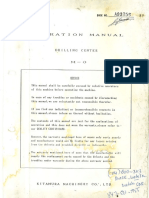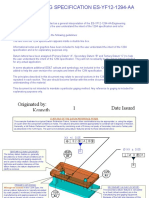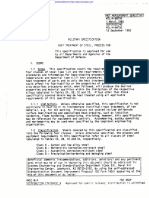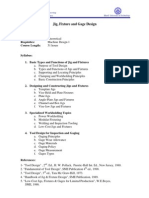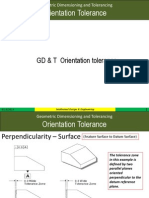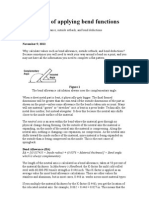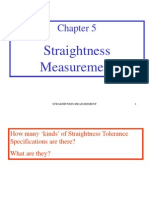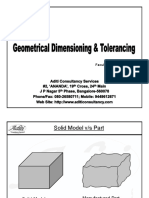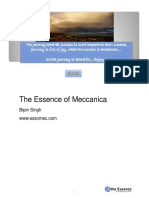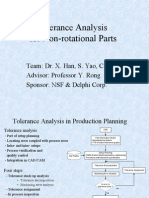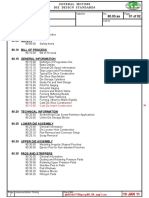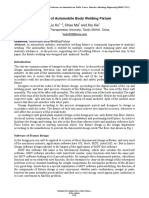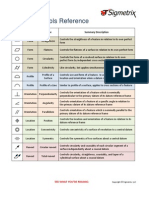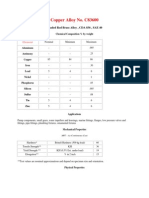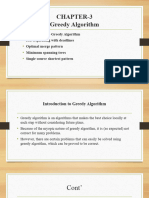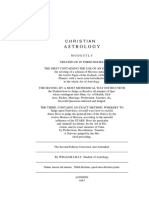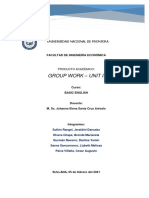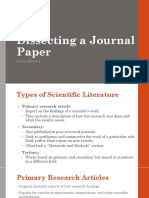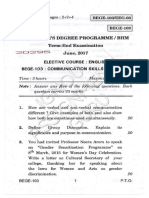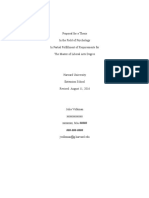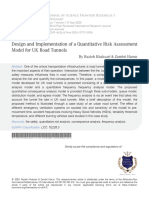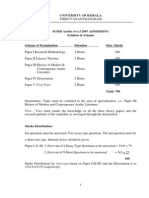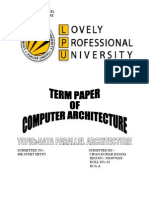0 ratings0% found this document useful (0 votes)
1K viewsGT&D Symbols
GT&D Symbols
Uploaded by
shawntsungThis document provides a summary of geometric dimensioning and tolerancing (GD&T) symbols and standards. It includes a chart that defines GD&T symbols and their characteristics. It also discusses GD&T data exchange between CAD systems, GD&T representation and validation, relevant ISO and ASME standards, and standards for GD&T data exchange and integration.
Copyright:
© All Rights Reserved
Available Formats
Download as PDF, TXT or read online from Scribd
GT&D Symbols
GT&D Symbols
Uploaded by
shawntsung0 ratings0% found this document useful (0 votes)
1K views8 pagesThis document provides a summary of geometric dimensioning and tolerancing (GD&T) symbols and standards. It includes a chart that defines GD&T symbols and their characteristics. It also discusses GD&T data exchange between CAD systems, GD&T representation and validation, relevant ISO and ASME standards, and standards for GD&T data exchange and integration.
Original Title
GT&d Symbols
Copyright
© © All Rights Reserved
Available Formats
PDF, TXT or read online from Scribd
Share this document
Did you find this document useful?
Is this content inappropriate?
This document provides a summary of geometric dimensioning and tolerancing (GD&T) symbols and standards. It includes a chart that defines GD&T symbols and their characteristics. It also discusses GD&T data exchange between CAD systems, GD&T representation and validation, relevant ISO and ASME standards, and standards for GD&T data exchange and integration.
Copyright:
© All Rights Reserved
Available Formats
Download as PDF, TXT or read online from Scribd
Download as pdf or txt
0 ratings0% found this document useful (0 votes)
1K views8 pagesGT&D Symbols
GT&D Symbols
Uploaded by
shawntsungThis document provides a summary of geometric dimensioning and tolerancing (GD&T) symbols and standards. It includes a chart that defines GD&T symbols and their characteristics. It also discusses GD&T data exchange between CAD systems, GD&T representation and validation, relevant ISO and ASME standards, and standards for GD&T data exchange and integration.
Copyright:
© All Rights Reserved
Available Formats
Download as PDF, TXT or read online from Scribd
Download as pdf or txt
You are on page 1of 8
Symbols[edit]
Tolerances: Type of Tolerances; 1) Unilateral 2) Bi- Lateral type
Geometric tolerancing reference chart
Per ASME Y14.5 M-1982
Type of
tolerance
Geometric
characteristics
Symbo
l
Characte
r
(Unicode)
Can be
applied
to a
surface
?
Can be
applie
d to a
feature
of
size?
Can affect
virtual
condition
?
Datum
referenc
e used?
Can use
modifier
?
Can use
modifier
?
Can be
affected
by a
bonus
tolerance
?
Can be
affected
by a shift
tolerance
?
Location
Positional
Tolerance
U+2316
No Yes Yes Yes Yes Yes
Yes
(note 4)
Yes
(note 3)
Form Straightness
U+23E4
Yes Yes
Yes
(note 1)
No
Yes
(note 1)
No
(note 5)
Yes
(note 4)
No
Form
Planarity
(flatness)
U+23E5
Yes No No No No
No
(note 5)
No No
Form Circularity
U+25CB
Yes No No No No
No
(note 5)
No No
Form Cylindricity
U+232D
Yes No No No No
No
(note 5)
No No
Profile Profile of a line
U+2312
Yes No No
Yes
(note 2)
No
No
(note 5)
No
Yes
(note 3)
Profile
Profile of a
surface
U+2313
Yes No No
Yes
(note 2)
No
No
(note 5)
No
Yes
(note 3)
Orientatio
n
Perpendicularit
y
U+27C2
Yes Yes
Yes
(note 1)
Yes
Yes
(note 1)
No
(note 5)
Yes
(note 4)
Yes
(note 3)
Orientatio
n
Angularity
U+2220
Yes Yes
Yes
(note 1)
Yes
Yes
(note 1)
No
(note 5)
Yes
(note 4)
Yes
(note 3)
Geometric tolerancing reference chart
Per ASME Y14.5 M-1982
Type of
tolerance
Geometric
characteristics
Symbo
l
Characte
r
(Unicode)
Can be
applied
to a
surface
?
Can be
applie
d to a
feature
of
size?
Can affect
virtual
condition
?
Datum
referenc
e used?
Can use
modifier
?
Can use
modifier
?
Can be
affected
by a
bonus
tolerance
?
Can be
affected
by a shift
tolerance
?
Orientatio
n
Parallelism
U+2225
Yes Yes
Yes
(note 1)
Yes
Yes
(note 1)
No
(note 5)
Yes
(note 4)
Yes
(note 3)
Location Concentricity
U+25CE
No Yes Yes Yes No
No
(note 5)
No No
Runout Circular runout
U+2197
Yes Yes
Yes
(note 1)
Yes No
No
(note 5)
No No
Runout Total runout
U+2330
Yes Yes
Yes
(note 1)
Yes No
No
(note 5)
No No
Location Symmetry
U+232F
?
(note 6)
?
(note 6)
?
(note 6)
?
(note 6)
?
(note 6)
?
(note 6)
?
(note 6)
?
(note 6)
Notes:
1. When applied to a feature-of-size.
2. Can also be used as a form control without a datum reference.
3. When a datum feature-of-size is referenced with the MMC modifier.
4. When an MMC modifier is used.
5. Automatic per rule #3.
6. The symmetry symbol's characteristics were not included in the version of the chart that this chart is derived from. The
symmetry symbol was dropped from the Y14.5M standard around 1982 and re-added around 1994.
Symbols used in a "feature control frame" to specify a feature's description, tolerance, modifier and datum references
Symbol Modifier Notes
Symbols used in a "feature control frame" to specify a feature's description, tolerance, modifier and datum references
Symbol Modifier Notes
Free state
Least material condition (LMC)
Maximum material condition (MMC)
Projected tolerance zone
Regardless of feature size (RFS) Not part of the 1994 version. See para. A5, bullet 3. Also para. D3. Also, Figure 3-8.
Tangent plane
Unilateral Appears in the 2009 version of the standard, and refers to unequal profile distribution.
Datums and datum references[edit]
A datum is a virtual ideal plane, line, point, or axis. A datum feature is a physical feature of a part identified by a datum feature
symbol and corresponding datum feature triangle, e.g.,
These are then referred to by one or more datum references which indicate measurements that should be made with respect to the
corresponding datum feature.
GD&T data exchange[edit]
Exchange of geometric dimensioning and tolerancing (GD&T) information between CAD systems is available on different levels of
fidelity for different purposes:
In the early days of CAD exchange only lines, texts and symbols were written into the exchange file. A receiving system could
display them on the screen or print them out, but only a human could interpret them.
GD&T presentation: On a next higher level the presentation information is enhanced by grouping them together into callouts
for a particular purpose, e.g. a datum feature callout and a datum reference frame. And there is also the information which of
the curves in the exchange file are leader, projection or dimension curves and which are used to form the shape of a product.
GD&T representation: Unlike GD&T presentation, the GD&T representation does not deal with how the information is
presented to the user but only deal with which element of a shape of a product has which GD&T characteristic. A system
supporting GD&T representation may display the GD&T information in some tree and other dialogs and allow the user to
directly select and highlight the corresponding feature on the shape of the product, 2D and 3D.
Ideally both GD&T presentation and representation are available in the exchange file and are associated with each other. Then
a receiving system can allow a user to select a GD&T callout and get the corresponding feature highlighted on the shape of the
product.
An enhancement of GD&T representation is defining a formal language for GD&T (similar to a programming language) which
also has built-in rules and restrictions for the proper GD&T usage. This is still a research area (see below reference to McCaleb
and ISO 10303-1666).
GD&T validation: Based on GD&T representation data (but not on GD&T presentation) and the shape of a product in some
useful format (e.g. a boundary representation), it is possible to validate the completeness and consistency of the GD&T
information. The software tool FBTol from the Kansas City Plant is probably the first one in this area.
GD&T representation information can also be used for the software assisted manufacturing planning and cost calculation of
parts. See ISO 10303-224 and 238 below.
GD&T[edit]
ISO TC 10 Technical product documentation[edit]
ISO 128 Technical drawings Indication of dimensions and tolerances
ISO 7083 Symbols for geometrical tolerancing Proportions and dimensions
ISO 13715 Technical drawings Edges of undefined shape Vocabulary and indications
ISO 15786 Simplified representation and dimensioning of holes
ISO 16792:2006 Technical product documentationDigital product definition data practices (Note: ISO 16792:2006 was
derived from ASME Y14.41-2003 by permission of ASME)
ISO 2010
ISO
ISO/TC 213 Dimensional and geometrical product specifications and verification[edit]
In ISO/TR 14638 GPS Masterplan the distinction between fundamental, global, general and complementary GPS standards is made.
Fundamental GPS standards
o ISO 8015 Concepts, principles and rules
Global GPS standards
o ISO 14660-1 Geometrical features
o ISO/TS 17, orientation and location
o ISO 1101 Geometrical tolerancing Tolerances of form, orientation, location and run-out
Amendment 1 Representation of specifications in the form of a 3D model
o ISO 1119 Series of conical tapers and taper angles
o ISO 2692 Geometrical tolerancing Maximum material requirement (MMR), least material requirement (LMR) and
reciprocity requirement (RPR)
o ISO 3040 Dimensioning and tolerancing Cones
o ISO 5458 Geometrical tolerancing Positional tolerancing
o ISO 5459 Geometrical tolerancing Datums and datum systems
o ISO 10578 Tolerancing of orientation and location Projected tolerance zone
o ISO 10579 Dimensioning and tolerancing Non-rigid parts
o ISO 14406 Extraction
o ISO 22432 Features utilized in specification and verification
General GPS standards: Areal and profile surface texture
o ISO 1302 Indication of surface texture in technical product documentation
o ISO 3274 Surface texture: Profile method Nominal characteristics of contact (stylus) instruments
o ISO 4287 Surface texture: Profile method Terms, definitions and surface texture parameters
o ISO 4288 Surface texture: Profile method Rules and procedures for the assessment of surface texture
o ISO 8785 Surface imperfections Terms, definitions and parameters
o Form of a surface independent of a datum or datum system. Each of them has a part 1 for the Vocabulary and
parameters and a part 2 for the Specification operators:
ISO 12180 Cylindricity
ISO 12181 Roundness
ISO 12780 Straightness
ISO 12781 Flatness
o ISO 25178 Surface texture: Areal
General GPS standards: Extraction and filtration techniques
o ISO/TS 1661 Filtration
o ISO 11562 Surface texture: Profile method Metrological characteristics of phase correct filters
o ISO 12085 Surface texture: Profile method Motif parameters
o ISO 13565 Profile method; Surfaces having stratified functional properties
ASME standards American Society of Mechanical Engineers[edit]
ASME Y14.41-2003 Digital Product Definition Data Practices
ASME Y14.5 - 2009 Dimensioning and Tolerancing
ASME Y14.5M-1994 Dimensioning and Tolerancing
ASME Y14.5.1M-1994 Mathematical Definition of Dimensioning and Tolerancing Principles
ASME Y14.5.1M-2
GD&T standards for data exchange and integration[edit]
ISO 10303 Industrial automation systems and integration Product data representation and exchange
o ISO 10303-47 Integrated generic resource: Shape variation tolerances
o ISO/TS 10303-1130 Application module: Derived shape element
o ISO/TS 10303-1050 Application module: Dimension tolerance
o ISO/TS 10303-1051 Application module: Geometric tolerance
o ISO/TS 10303-1052 Application module: Default tolerance
o ISO/TS 10303-1666 Application module: Extended geometric tolerance
o ISO 10303-203 Application protocol: Configuration controlled 3D design of mechanical parts and assemblies
o ISO 10303-210 Application protocol: Electronic assembly, interconnection, and packaging design
o ISO 10303-214 Application protocol: Core data for automotive mechanical design processes
o ISO 10303-224 Application protocol: Mechanical product definition for process planning using machining features
o ISO 10303-238 Application protocol: Application interpreted model for computerized numerical controllers (STEP-
NC)
See also[edit]
Specification of surface finish
References[edit]
This article includes a list of references, but its sources remain unclear because it has insufficient inline citations. Please
help to improve this article by introducing more precise citations. (April 2010)
1. Jump up ^ Dimensioning and Tolerancing, ASME y14.5-2009. NY: American Society of Mechanical Engineers. 2009. ISBN 0-7918-
3192-2.
Further reading[edit]
This article lacks ISBNs for the books listed in it. Please make it easier to conduct research by listing ISBNs. If the {{Cite
book}} or {{citation}} templates are in use, you may add ISBNs automatically, or discuss this issue on the talk page. (October
2011)
McCale, Michael R. (1999). "A Conceptual Data Model of Datum Systems". Journal of Research of the National Institute of
Standards and Technology 104 (4): 349400. doi:10.6028/jres.104.024.
HENZOLD, Georg. Geometrical Dimensioning and Tolerancing for Design, Manufacturing and Inspection. 2nd Edition,
Elsevier, Oxford, UK, 2006.
Srinivasan, Vijay (2008). "Standardizing the specification, verification, and exchange of product geometry: Research, status
and trends". Computer-Aided Design 40 (7): 73849. doi:10.1016/j.cad.2007.06.006.
DRAKE JR, Paul J. Dimensioning and Tolerancing Handbook. McGraw-Hill, New York, 1999
Neumann, Scott and Al Neumann. GeoTol Pro: A Practical Guide to Geometric Tolerancing per ASME Y14.5-2009. Society
of Manufacturing Engineers, Dearborn, MI, 2009. ISBN # 978-0-8726-3865-5
Bramble, Kelly L. Geometric Boundaries II, Practical Guide to Interpretation and Application ASME Y14.5-2009, Engineers
Edge, 2009
Wilson, Bruce A. (2005). Design Dimensioning and Tolerancing. US: Goodheart-Wilcox. p. 275. ISBN 9781590703281.
External links[edit]
Wikimedia Commons has media related to Geometric dimensioning and tolerancing.
General tolerances for linear and angular dimensions according to ISO 2768
Interactive map of GD&T. jj
What is GD&T
The importance of GD&T
GD&T Glossary of Terms and Definitions
Free GD&T Help and Tips
Justification for GD&T
GDT: Introduction
ASME Certification
Changes and Additions to ASME Y14.5M
You might also like
- My Center ManualDocument223 pagesMy Center Manualshawntsung50% (2)
- Ats Ml-580 ManualDocument118 pagesAts Ml-580 Manualshawntsung0% (1)
- Resume Workshop PowerpointDocument24 pagesResume Workshop PowerpointPoddar training placement Jaipur100% (2)
- GDTDocument38 pagesGDTAntonio CervantesNo ratings yet
- GDT-True PositionDocument32 pagesGDT-True Positionhamartinez100% (1)
- Mil H 6875HDocument29 pagesMil H 6875Hshawntsung100% (1)
- GT&D GlossaryDocument10 pagesGT&D GlossaryshawntsungNo ratings yet
- Talolong River in Lopez Quezon Basis For Project LILIDocument53 pagesTalolong River in Lopez Quezon Basis For Project LILIJV Villanueva0% (1)
- Duratray TraysDocument6 pagesDuratray TraysAlejandroZappaNo ratings yet
- GDT TutorialDocument76 pagesGDT TutorialSrk ChowdaryNo ratings yet
- GD&T 1Document69 pagesGD&T 1JayanthiANo ratings yet
- GDT Day1Document119 pagesGDT Day1Narendrareddy Ramireddy100% (1)
- SolidWorks 2015 Learn by doing-Part 3 (DimXpert and Rendering)From EverandSolidWorks 2015 Learn by doing-Part 3 (DimXpert and Rendering)Rating: 4.5 out of 5 stars4.5/5 (5)
- GD&T Self Evaluation Test - Difficulty Level - 9 (Of 10)Document27 pagesGD&T Self Evaluation Test - Difficulty Level - 9 (Of 10)dilipbangaruNo ratings yet
- 62 Design Specification For Gauges EnglishDocument17 pages62 Design Specification For Gauges EnglishShawn WaltzNo ratings yet
- Geometric Dimensioning & TolerancingDocument47 pagesGeometric Dimensioning & TolerancingVinoth Balasubramaniyan100% (1)
- Global Standart NaamsDocument513 pagesGlobal Standart NaamsLALO MNo ratings yet
- Rule #1 Explained: 2.7.1 Variations of Form (Rule #1: Envelope Principle)Document6 pagesRule #1 Explained: 2.7.1 Variations of Form (Rule #1: Envelope Principle)Anonymous 7ZTcBnNo ratings yet
- Jig-Fixture & Gage Design755344060Document1 pageJig-Fixture & Gage Design755344060kpreddy_6171No ratings yet
- Functional Gage DesignDocument32 pagesFunctional Gage DesignShawn Waltz100% (2)
- Geometric Dimensioning and Tolerancing: FundamentalsDocument40 pagesGeometric Dimensioning and Tolerancing: FundamentalsdramiltNo ratings yet
- Fine Blanking TechnologyDocument30 pagesFine Blanking TechnologyEngineer100% (2)
- EPM212 - Chapter 9 Slides GD T HandoutDocument15 pagesEPM212 - Chapter 9 Slides GD T HandoutJosephRomeraloNo ratings yet
- Summary-Geometrical Tolerance - I - 07-2006 - Rev ADocument10 pagesSummary-Geometrical Tolerance - I - 07-2006 - Rev AMhs EngineerNo ratings yet
- Marking ToolsDocument14 pagesMarking ToolsFabian NdegeNo ratings yet
- Check Fixture Standards Rev 4 Dated 9-10-2019Document11 pagesCheck Fixture Standards Rev 4 Dated 9-10-2019SasiNo ratings yet
- ASME Y14.5 Vs ISO GPS Comparison ChartDocument2 pagesASME Y14.5 Vs ISO GPS Comparison ChartMohammad Ghousuddin100% (1)
- Orientation Tolerance GDTDocument30 pagesOrientation Tolerance GDTGanesanGovindarjNo ratings yet
- GD&TDocument10 pagesGD&TShahed FacebookNo ratings yet
- The Basics of Applying Bend FunctionsDocument18 pagesThe Basics of Applying Bend Functionssssf-dobojNo ratings yet
- 05 StraightnessMeasurement90Document90 pages05 StraightnessMeasurement90maddy_scribdNo ratings yet
- Lecture 8 - Position TolerancingDocument26 pagesLecture 8 - Position TolerancingEdgar IvanNo ratings yet
- Gauge StandardsDocument12 pagesGauge StandardsHector Martinez100% (1)
- Engr 22 Lec 20 Sp07 GDT 2 Bonus TolDocument28 pagesEngr 22 Lec 20 Sp07 GDT 2 Bonus TolpdmnbraoNo ratings yet
- 01 Ih - Stamping FundamentalsDocument24 pages01 Ih - Stamping FundamentalsDiego AcostaNo ratings yet
- Geometric Dimensioning & Tolerancing (GD&T)Document89 pagesGeometric Dimensioning & Tolerancing (GD&T)Vijay PawarNo ratings yet
- Geometric Dimensioning and Tolerancing GD&TDocument17 pagesGeometric Dimensioning and Tolerancing GD&TJusuf ElQudsyNo ratings yet
- Position Measurement On Machine ToolsDocument13 pagesPosition Measurement On Machine ToolsAriel GermainNo ratings yet
- GD&T - Aditi Consultancy Services PDFDocument61 pagesGD&T - Aditi Consultancy Services PDFRaghunath Anandakrishna0% (1)
- GD&T ReferenceDocument2 pagesGD&T ReferenceJosh ByronNo ratings yet
- True Position - GD&T BasicsDocument55 pagesTrue Position - GD&T BasicsManoj Singh100% (1)
- Guide Lines For Tooling Design Before Taking For DesignDocument5 pagesGuide Lines For Tooling Design Before Taking For DesignramprakashchinniahNo ratings yet
- ABC Group Checking and Gauge Standard 80-STD-D-01Document53 pagesABC Group Checking and Gauge Standard 80-STD-D-01Quy HoangNo ratings yet
- G4 - Advance GD&T and Tolerance Stack-UpDocument9 pagesG4 - Advance GD&T and Tolerance Stack-UpAnkit NaphadeNo ratings yet
- Tolerance AnalysisDocument10 pagesTolerance Analysisdineshnexus100% (1)
- Relationships Between Material Modifiers and FitsDocument3 pagesRelationships Between Material Modifiers and FitsDo The CuongNo ratings yet
- General Motors Die Design StandardsDocument133 pagesGeneral Motors Die Design Standardscasber serviciosNo ratings yet
- Chapter 6. Tolerance Stack Up AnalysisDocument31 pagesChapter 6. Tolerance Stack Up AnalysisNguyên Bành Quốc100% (1)
- Design of BIW Welding FixturesDocument3 pagesDesign of BIW Welding FixturesRawendrraw KuriNo ratings yet
- BendWorks PDFDocument9 pagesBendWorks PDFLiam Choon Seng100% (1)
- Prepared by Deepak A Vishwakarma .: Roll No L081040008 T Y B Tech ProductionDocument30 pagesPrepared by Deepak A Vishwakarma .: Roll No L081040008 T Y B Tech ProductionDIPAK VINAYAK SHIRBHATE100% (2)
- Geometrical Dimenstioning and ToleranceDocument82 pagesGeometrical Dimenstioning and ToleranceSreedhar PugalendhiNo ratings yet
- Differences ASME and ISO GD&TDocument2 pagesDifferences ASME and ISO GD&TKeith AdminNo ratings yet
- GD&T Symbols Reference GuideDocument2 pagesGD&T Symbols Reference Guidecreating_24No ratings yet
- GD&T Reference ChartDocument1 pageGD&T Reference ChartZdravko VidakovicNo ratings yet
- Geometric Dimensioning And Tolerancing A Complete Guide - 2020 EditionFrom EverandGeometric Dimensioning And Tolerancing A Complete Guide - 2020 EditionNo ratings yet
- GD&T SymbolsDocument4 pagesGD&T SymbolspolumathesNo ratings yet
- Geometric Dimensioning and Tolerancing: Navigation Search Citations Reliable and Independent SourcesDocument8 pagesGeometric Dimensioning and Tolerancing: Navigation Search Citations Reliable and Independent SourcesDeepak LogesonNo ratings yet
- ANSI and ISO Geometric Tolerancing Symbols1Document5 pagesANSI and ISO Geometric Tolerancing Symbols1Mahender KumarNo ratings yet
- Standard ThreadmillsDocument1 pageStandard ThreadmillsshawntsungNo ratings yet
- Getting Started With Mastercam LatheDocument132 pagesGetting Started With Mastercam LatheshawntsungNo ratings yet
- MCFSW Tutorial PDFDocument60 pagesMCFSW Tutorial PDFEric WoodsNo ratings yet
- CARC Paint 37-011-0313Document2 pagesCARC Paint 37-011-0313shawntsungNo ratings yet
- Haas Lathe Operator ManualDocument154 pagesHaas Lathe Operator Manualshawntsung100% (1)
- Creo Basic UdfDocument612 pagesCreo Basic Udfneeraj kumarNo ratings yet
- Guia Mastercam v9Document454 pagesGuia Mastercam v9Edson Sawada100% (2)
- Beryllium CopperDocument2 pagesBeryllium Coppershawntsung100% (1)
- GDT Basic Skill SurveyDocument4 pagesGDT Basic Skill SurveyshawntsungNo ratings yet
- FITS MetricDocument6 pagesFITS MetricshawntsungNo ratings yet
- C83600 (Red Brass) PDFDocument2 pagesC83600 (Red Brass) PDFshawntsungNo ratings yet
- PTC Creo 2.0 Config OptionsDocument24 pagesPTC Creo 2.0 Config OptionsshawntsungNo ratings yet
- Sequence of Programming Steps For PartMaker SwissCAMDocument1 pageSequence of Programming Steps For PartMaker SwissCAMshawntsungNo ratings yet
- GDT Basic Skill SurveyDocument4 pagesGDT Basic Skill SurveyshawntsungNo ratings yet
- Beryllium CopperDocument2 pagesBeryllium Coppershawntsung100% (1)
- Copper Alloy Cross ReferencesDocument3 pagesCopper Alloy Cross ReferencesshawntsungNo ratings yet
- Tolerancias JS-13Document8 pagesTolerancias JS-13FlavioNocelli100% (2)
- Reed Thread Roll AttachmentDocument2 pagesReed Thread Roll AttachmentshawntsungNo ratings yet
- The 7 Habits of Highly Effective People: Adopted From: Book by Stephen R Covey Adopted By: Prof. KumargauravDocument18 pagesThe 7 Habits of Highly Effective People: Adopted From: Book by Stephen R Covey Adopted By: Prof. KumargauravVishal RudachNo ratings yet
- List of Therapeutic Communication and Their ClassificationDocument1 pageList of Therapeutic Communication and Their ClassificationLillabinNo ratings yet
- Chapter 3Document33 pagesChapter 3mikiberhanu41No ratings yet
- PPM - SyllabusDocument13 pagesPPM - SyllabusJoseph Kanyi King'ori - HonNo ratings yet
- Ca Iii PDFDocument375 pagesCa Iii PDFHijNo ratings yet
- Sesión 14. - Producto Group Work - 05-02-2021 - Grupo 2Document6 pagesSesión 14. - Producto Group Work - 05-02-2021 - Grupo 2SULLON RANGEL JERALDINI DANUSKANo ratings yet
- Dissecting A Journal PaperDocument17 pagesDissecting A Journal PaperalyrNo ratings yet
- Suhas ProjectDocument85 pagesSuhas ProjectHemanth KumarNo ratings yet
- BEGE-103-EEG-03 - J17 - CompressedDocument4 pagesBEGE-103-EEG-03 - J17 - CompressedO ONo ratings yet
- Julia Volkman Spelling in Preschool Children PDFDocument37 pagesJulia Volkman Spelling in Preschool Children PDFDonna Karen Calzada ChanNo ratings yet
- Etech Finals ExamDocument3 pagesEtech Finals ExamKennedy Fieldad VagayNo ratings yet
- Roger Malina On Jim Campbell Art Series "Illuminated Averages"Document2 pagesRoger Malina On Jim Campbell Art Series "Illuminated Averages"roger malinaNo ratings yet
- HW 3 SolDocument3 pagesHW 3 Solavni1601No ratings yet
- Unit 1 Health Care Information Regulations, Laws and StandardsDocument59 pagesUnit 1 Health Care Information Regulations, Laws and StandardsALEXANDRA MARIE BUNQUIN100% (1)
- Peac Documentation Checklist: Folder A: School Philosophy, Vision, Mission, Goals/Objectives Exhibits/DocumentsDocument3 pagesPeac Documentation Checklist: Folder A: School Philosophy, Vision, Mission, Goals/Objectives Exhibits/DocumentsMark Charle Mana100% (3)
- Report Feb 7 - 11Document15 pagesReport Feb 7 - 11birhane gebreegziabiherNo ratings yet
- Design and ImplementationDocument9 pagesDesign and ImplementationbaranNo ratings yet
- M.Phil Arabic Syllabus at Kerala UniversityDocument5 pagesM.Phil Arabic Syllabus at Kerala Universitythajudeenmannani100% (1)
- AABC TAB Journal 2001 SummerDocument30 pagesAABC TAB Journal 2001 SummerBalanSelvamNo ratings yet
- Tugas Bahasa InggrisDocument7 pagesTugas Bahasa InggrisGue Gitu LochNo ratings yet
- November 2017Document64 pagesNovember 2017Treatment Plant Operator MagazineNo ratings yet
- Find PDFDocument1 pageFind PDFanand chowdaryNo ratings yet
- China and Africa - BibliographyDocument265 pagesChina and Africa - BibliographyDavid Shinn100% (2)
- Detailed Lesson Plan 2Document6 pagesDetailed Lesson Plan 2Merry Joy Necio BongatoNo ratings yet
- Data Parallel ArchitectureDocument17 pagesData Parallel ArchitectureSachin Kumar BassiNo ratings yet
- Assignment Progress Group 4Document6 pagesAssignment Progress Group 4Nayli Abdul RahimNo ratings yet
- Bailiff: All Rise. Ecumenical Prayer For The CourtsDocument10 pagesBailiff: All Rise. Ecumenical Prayer For The CourtsKit ChampNo ratings yet
